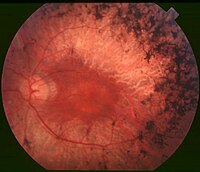
Ranibizumab for choroidal neovascularization secondary to pseudoxanthoma elasticum: 4-year results from the PIXEL study in France
Sign Up to like & getrecommendations! Published in 2017 at "Graefe's Archive for Clinical and Experimental Ophthalmology"
DOI: 10.1007/s00417-017-3685-y
Abstract: PurposeTo evaluate the long-term effectiveness and safety of ranibizumab 0.5 mg in patients with choroidal neovascularization (CNV) secondary to pseudoxanthoma elasticum (PXE) in a real-world setting.MethodsA descriptive, observational, multicenter study in a retrospective and prospective cohort… read more here.
Keywords: choroidal neovascularization; ranibizumab; year; safety ... See more keywords

Aflibercept for choroidal neovascularizations secondary to pseudoxanthoma elasticum: a prospective study
Sign Up to like & getrecommendations! Published in 2019 at "Graefe's Archive for Clinical and Experimental Ophthalmology"
DOI: 10.1007/s00417-019-04551-4
Abstract: Purpose To evaluate the use of 2 mg intravitreal aflibercept for treatment of choroidal neovascularization (CNV) secondary to angioid streaks in patients with pseudoxanthoma elasticum (PXE). Methods In this 12-month prospective, open-label, uncontrolled, non-randomized interventional clinical… read more here.
Keywords: choroidal neovascularizations; aflibercept choroidal; pseudoxanthoma elasticum; neovascularizations secondary ... See more keywords

Genotype-phenotype correlation in pseudoxanthoma elasticum.
Sign Up to like & getrecommendations! Published in 2021 at "Atherosclerosis"
DOI: 10.1016/j.atherosclerosis.2021.03.012
Abstract: BACKGROUND AND AIMS Pseudoxanthoma elasticum (PXE) is caused by variants in the ABCC6 gene. It results in calcification in the skin, peripheral arteries and the eyes, but has considerable phenotypic variability. We investigated the association… read more here.
Keywords: truncating variants; genotype phenotype; pseudoxanthoma elasticum; genotype ... See more keywords

Cellular signaling in pseudoxanthoma elasticum: an update.
Sign Up to like & getrecommendations! Published in 2019 at "Cellular signalling"
DOI: 10.1016/j.cellsig.2018.12.009
Abstract: Pseudoxanthoma elasticum is an autosomal recessive genodermatosis with variable expression, due to mutations in the ABCC6 or ENPP1 gene. It is characterized by elastic fiber mineralization and fragmentation, resulting in skin, eye and cardiovascular symptoms.… read more here.
Keywords: elasticum update; signaling pseudoxanthoma; cellular signaling; pseudoxanthoma elasticum ... See more keywords

Mutation spectrum in the ABCC6 gene and genotype–phenotype correlations in a French cohort with pseudoxanthoma elasticum
Sign Up to like & getrecommendations! Published in 2017 at "Genetics in Medicine"
DOI: 10.1038/gim.2016.213
Abstract: Purpose:Pseudoxanthoma elasticum (PXE) is an autosomal recessive disorder caused by variants in the ABCC6 gene. Ectopic mineralization of connective tissues leads to skin, eye, and cardiovascular manifestations with considerable phenotypic variability of unknown cause. We… read more here.
Keywords: phenotype; genotype phenotype; phenotype correlations; pseudoxanthoma elasticum ... See more keywords

A novel ABCC6 variant causative of pseudoxanthoma elasticum
Sign Up to like & getrecommendations! Published in 2019 at "Human Genome Variation"
DOI: 10.1038/s41439-019-0062-x
Abstract: Pseudoxanthoma elasticum is an autosomal recessive heritable disorder caused by mutations in ABCC6. We describe two siblings showing typical skin lesions and a clinical diagnosis of pseudoxanthoma elasticum. Genetic analysis of ABCC6 revealed a novel… read more here.
Keywords: pseudoxanthoma; pseudoxanthoma elasticum; novel abcc6; abcc6 variant ... See more keywords

A stalactite in the aorta. Abnormal calcification in a patient with pseudoxanthoma elasticum
Sign Up to like & getrecommendations! Published in 2017 at "Acta Cardiologica"
DOI: 10.1080/00015385.2017.1281555
Abstract: Received on 1 February 2016; accepted for publication 8 February 2016. Pseudoxanthoma Elasticum (PXE) is a rare, inherited (autosomal recessive) disease with a prevalence of 1 in 25,000-100,000. It is a multisystem disorder caused by… read more here.
Keywords: aorta abnormal; abnormal calcification; stalactite aorta; pseudoxanthoma elasticum ... See more keywords

Hickam’s Dictum: Pseudoxanthoma elasticum and Usher syndrome in a single patient
Sign Up to like & getrecommendations! Published in 2020 at "Ophthalmic Genetics"
DOI: 10.1080/13816810.2020.1790616
Abstract: ABSTRACT Background To report the case of a patient with two distinct genetic systemic diseases – pseudoxanthoma elasticum (PXE) and Usher syndrome – confirmed by genetic testing. Materials and Methods Single Retrospective Case Report Results… read more here.
Keywords: genetic testing; single patient; hickam dictum; pseudoxanthoma elasticum ... See more keywords

Pseudoxanthoma elasticum and retinitis pigmentosa in a patient with a novel mutation in the ABCC6 gene.
Sign Up to like & getrecommendations! Published in 2023 at "Ophthalmic genetics"
DOI: 10.1080/13816810.2023.2219737
Abstract: BACKGROUND Pseudoxanthoma elasticum (PXE) is an autosomal recessive condition caused by mutations in the ABCC6 gene. Ocular features include angioid streaks, peau d'orange fundus, and drusen. We report a novel ABCC6 mutation causing PXE in… read more here.
Keywords: patient novel; retinitis pigmentosa; patient; pseudoxanthoma elasticum ... See more keywords

Two cases of periumbilical perforating pseudoxanthoma elasticum with dermoscopic and histopathologic features
Sign Up to like & getrecommendations! Published in 2020 at "Australasian Journal of Dermatology"
DOI: 10.1111/ajd.13243
Abstract: Periumbilical perforating pseudoxanthoma elasticum is a rare acquired disorder, whose classification is still debatable. It may be a localised cutaneous variant type of pseudoxanthoma elasticum (although it may affect internal organs) or a separate disease… read more here.
Keywords: periumbilical perforating; pseudoxanthoma elasticum; perforating pseudoxanthoma; two cases ... See more keywords

Severe early‐onset manifestations of pseudoxanthoma elasticum resulting from the cumulative effects of several deleterious mutations in ENPP1, ABCC6 and HBB: transient improvement in ectopic calcification with sodium thiosulfate
Sign Up to like & getrecommendations! Published in 2019 at "British Journal of Dermatology"
DOI: 10.1111/bjd.18632
Abstract: Pseudoxanthoma elasticum (PXE) is a rare disorder characterized by fragmentation and progressive calcification of elastic fibres in connective tissues. Overlap has been reported between the inherited PXE phenotype associated with ENPP1, ABCC6 or NT5E mutations… read more here.
Keywords: thiosulfate; early onset; pxe; severe early ... See more keywords